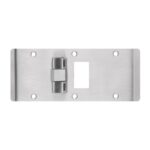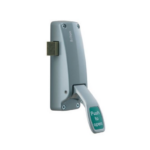I occasionally publish a post from a guest blogger – if you have a post you’d like to share, drop me an email. Today’s post is from Kenny Abell of Allegion, and was printed in the July/August 2016 issue of Keynotes.
~~~
.
The growing popularity of access control systems has also increased the use of electrified locks, particularly in high-traffic areas where they are connected to an external wall reader and a power supply. The fundamental technology behind these locks has traditionally been a solenoid, but while it served the necessary purpose, it wasn’t without its disadvantages. This article explores an emerging number of locks that use a different technology — motors — to offer significant advantages in terms of energy efficiency, user experience and application flexibility.
Energy Efficiency
Solenoids are a coil of wire that contains a metal core. When electricity is passed through the coil, a magnetic field is generated that then acts upon the magnetic core and pushes it in a specific direction. The addition of springs and other mechanical linkages allow that solenoid to engage and disengage the locking features of a lock. While effective, it unfortunately isn’t energy efficient.
For solenoids to work, power must be applied to first move the solenoid into position, and then to keep it held in that position. For example, in an electrically locking door, the solenoid uses several hundred milliamps to initially lock the door and continues to use those several hundred milliamps to keep the door locked. Motors offer a different power paradigm. They offer some energy savings to initially lock the door, but once they are in either the locked or unlocked state, that current draw drops to near zero (typically only 10-20 milliamps). The difference is that solenoids have to constantly “push,” whereas once the motor is in position, it doesn’t require any expenditure. The small “holding current” for a motor is only required to keep the microprocessor “brain” of the lock powered up. Motors allow for a greener, more efficient implementation in the building.
User Experience
Energy efficiency also has a significant impact on the user experience with that lock. Because solenoids are constantly pushing when in operation, they are also consuming power, which generates heat – the enemy of electronics. Hollow metal doors offer space for that heat to dissipate, but wood doors have minimal ventilation. This means that heat goes out via the lock and results in the levers becoming warm — even hot — to the touch. This is particularly common in electrically locking (fail safe) applications or in electrically unlocking (fail secure) applications and where the door is left unlocked for long periods of time.
Motor-driven locks, however, don’t have this issue. Once the motor is in position, it doesn’t require those several hundred milliamps to operate — only the 10 or 20 to keep the microprocessor powered. This small holding current generates virtually zero heat and thus eliminates warm levers, even in applications with poorly ventilated wood doors.
Installation Flexibility
Although motors and solenoids are two very different technologies, their requirements are virtually identical. There are a few differences that will be noted for transparency, along with the many advantages of a motor solution.
Manufacturers have worked hard to keep the installation process between a solenoid-driven lock and motor-driven lock as similar as possible. One difference is that a motor-driven lock cannot accept AC voltage. This really is a difference, not an issue, as people have long been using power supplies with their locks instead of AC voltage going through a transformer. The other difference is that while solenoids don’t have polarity (i.e. they don’t have a plus or minus side), some manufacturers may require that the lock be wired with the positive charge going to a particular wire. This is a simple consideration for the installer and mentioned here for completeness.
A disadvantage of solenoids is that they are designed to be used at one specific voltage only — for example, 12 volts or 24 volts. Motor solutions, however, are designed to automatically accept either 12 or 24V DC. Also, solenoid solutions — because of their mechanical interface — are made at the factory as either electrically locking or electrically unlocking. With motor solutions, the operating mode can be changed as easily as flipping a switch on the job site. This makes installation and service much faster and easier, as people regularly get the operating mode confused. Because one lock can support all the common applications, you lower the chance of the wrong product being on the job site or the locksmith not having the right lock on the truck.
Another benefit to motors is that they are quieter than solenoids. Solenoids, by their nature, make loud “clicking” sounds. Motors are much quieter, and what noise they do generate is much less perceptible to building occupants.
A Proven Technology
Although its application on wired electrified locks is a recent development, motor technology has obviously been around for a very long time. It’s also been used on door hardware for many years as well; quiet electronic latching on exit devices use motors, as do advanced electronic locks. Motors in door hardware are well proven, and their transition into wired electrified locks are a natural progression of the technology.
Selecting a Motor Driven Lock
A number of manufacturers are now using motor-driven technology in their locks. Some manufacturers will identify their locks as using motors; others focus their marketing on the benefits rather than the technology itself. An easy way to tell which type of technology is used is whether or not the lock can automatically detect 12 or 24V; solenoid systems can’t do that, but motors will. Your spec writer and local manufacturer’s representative are also excellent references.
Innovation takes many forms, and the use of motors in wired electrified locks is a significant innovation in door hardware. Energy efficiency, improved user experience and installation flexibility combine to not only make a better building but a less expensive one as well.
~~~
Kenny Abell has served as the product and marketing manager of Schlage Commercial Locks at Allegion for five years, helping to launch multiple new products and develop positioning strategies for Schlage Commercial Locks and other products. Throughout Kenny’s career, he has worked in a variety of industries ranging from biomedical to consumer electronics, holding positions in manufacturing, quality, new product development, project management, tactical marketing and strategic marketing. He received his Master of Electrical Engineering degree from the University of Louisville and MBA from Indiana University.
This article was published in the July/August 2016 issue of Keynotes. A downloadable reprint is available here.
You need to login or register to bookmark/favorite this content.







Can an existing Schlage L90xx or L94xx be retrofitted with a motor?
Hello Bryan,
Unfortunately a mechanical or solenoid-based Schlage L series mortise lock cannot be upgraded to the motor design. The case, cover, and several internal parts were modified as part of the project and thus converting to the motor would literally require rebuilding the entire lock. That said, the new motor-driven Schlage L uses all the same trim as the previous L so if you want to upgrade an existing opening, you could re-use the existing levers, armor, strike, etc, and just change the lock body.
One additional benefit of the motor-driven Schlage L is that some of the electrified options are now “modular” – meaning you can add them yourself without opening the lock case. Currently we offer the RX as a module – while you can get it pre-installed from the factory, you can add it yourself by simply installing into a slot in the bottom of the chassis. Later this year, the door position sensor will also be available as a “plug in” module that can also easily be added. This adds to the inventory flexibility of the motorized product – one lock body can support 12 or 24V DC, EL or EU, with or without RX, and later this year with or without DPS. I’ve attached a link to the datasheet for more information (again note that only the pre-installed DPS is available at this time, so the modular DPS is not yet listed). http://us.allegion.com/IRSTDocs/InstallInstructions/110531_SC_L909x_Mortise_datasheet_110515.pdf
Best regards,
Kenny Abell
Product Manager, Schlage Locks
Can a motorized lock that is ordinarily locked, unlock on loss of power?